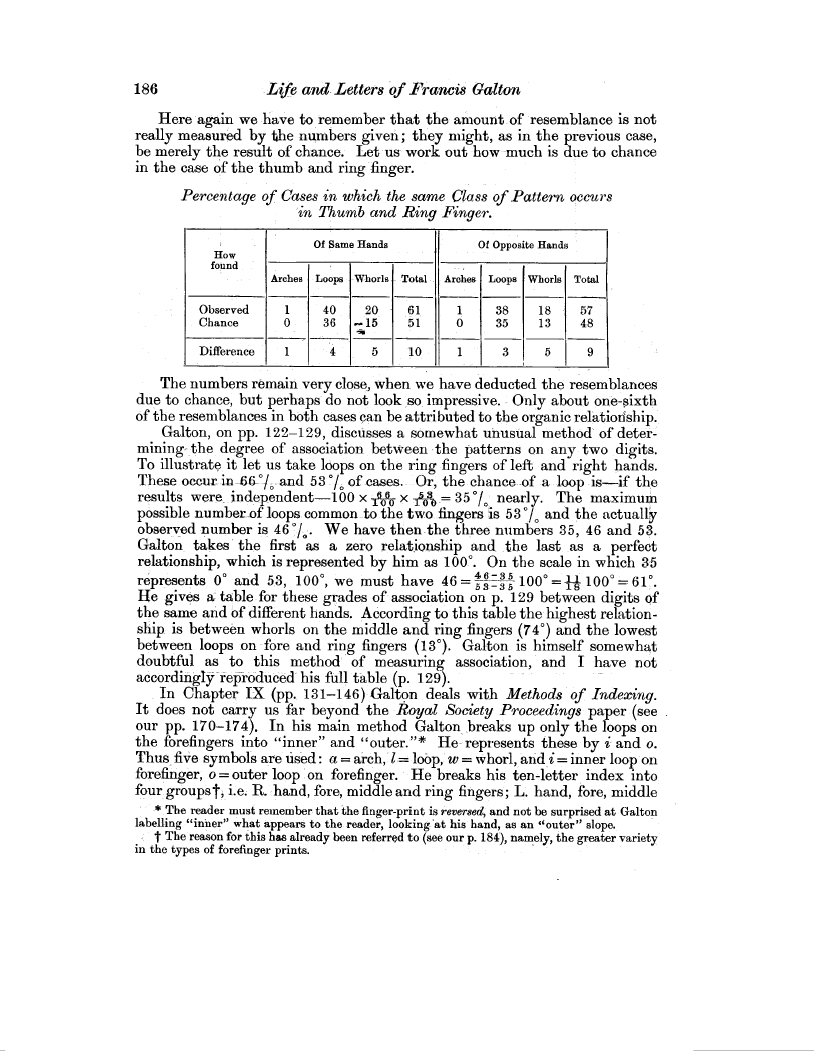| ||||||

OCR Rendition - approximate
186 Life and- Letters of Francis Galton Here again we have to remember that the amount of resemblance is not really measured by the numbers given ; they might, as in the previous case, be merely the result of chance. Let ua work out how much is due to chance in the case of the thumb and ring finger. Percentage of Cases in which the same Class of Pattern occurs 'in Thumb and Ring Finger.
The numbers remain very close, when we have deducted the resemblances due to chance, but perhaps do not look so impressive. Only about one-sixth of the resemblances in both cases can be attributed to the organic relation` ship. Galton, on pp. 122-129, discusses a somewhat unusual method of determining the degree of association between -the patterns on any two digits. To illustrate it let us take loops on the ring fingers of left and right hands. These occur in--fib-°/o-and 53 */.of cases. Or, the chance nearly. e maximum e 0~ - results were independent-100 x 00 X r 35 ance--oa l Thoo is -- of t possible number-of loops common to the two fingers is 53'/. and the actually observed number is 46'/.. We have then the three numbers 35, 46 and 53. Galton takes the first as a zero relationship and the last_ as a perfect relationship, which is represented by him as 100°. On the scale in which 35 represents 0° and 53, 100°, we must have 46 = 453-3 5 100° = 18 100'= 61°. He gives a' table for these grades of association on p. 129 between digits of the same and of different hands. According to this table the highest relationship is between whorls on the middle and ring fingers (74°) and the lowest between loops on fore and ring fingers (13°). Galton is himself somewhat doubtful as to this method' of measuring association, and I have not accordingly reproduced his full table (p. 129). In Chapter IX (pp. 131-146)-Galton deals with Methods of Indexing. It does not carry us far beyond the Royal Society Proceedings paper (see our pp. 170-174). In his main method Galton breaks up only the loops on the forefingers into "inner" and "outer." He-represents these by i- and o. Thus five symbols are used : a = arch, 1= loop, w = whorl, and i = inner loop on forefinger, o = outer loop on forefinger. He breaks his ten-letter index into, four groupst, i.e. R. hand, fore, middle and ring fingers; L. hand, fore, middle * The reader must remember that the finger-print is reversed, and not be surprised at Galton labelling "inner" what appears to the reader, looking' at his band, as an "outer" slope. I f The reason for this has already been referred to (see our p. 184), namely, the greater variety in the types of forefinger prints.
| |||||||||||||||||||||||||||||||||||||||||||||||||||||||||||